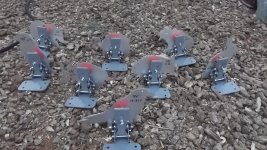Realistic colors on the face plates make it super hard to see your miss on the face plate! Same with a black face plate. Yes, it's the same for everyone... sort of.
The new shooters need feedback even more that the seasoned shooters. Especially if we want them to come back and play with us some more. If they can't see and adjust after misses, then, they get really, really frustrated. I've seen it many times.
I like to use bright, light colors, like light yellow, light blue, or white for face plates. These colors make it easy to find the target, especially when placed in the woods, or brush. That can be another frustrating thing for new and seasoned shooters.
And, those colors also make it easy to see your miss on the face plate,.. at least until the face plate gets totally shot up at the end of the larger matches... by then, the competitor should know what's happening with their pellets anyway.
I like to paint the kill paddles red or orange, and the back of the face plate white or silver like Scott mentioned already to reflect light onto the paddle.
I've also used "red tail light lens repair plastic tape" that adheres to the back of the face plate over the kill zone when a lot of competitors are attending a match and the targets are in hard to see locations. Even after 500 plus shots, there is always at least a ring of red tape left to outline the kill zone. Otherwise, the paddles get shot up after 5-10 competitors and again, you can't see where you are hitting in most cases. The tape is stretchy and the pellet hole kind of gets sealed up for a long time... allowing the competitors to see their hit much longer.
If the match is for a championship with all top shooters, then OK fine, make it as hard as possible to help weed out the competitors.. if that is what the MD wants.. but not me.
Dealing with the wind, 3/4 to 1" kill zones at 30-40 yards, and range finding is plenty enough challenge for this competitor and match director.
Wayne
 but had multi colors faces with yellow kz’s prior. Both ways seem to have advantages and disadvantages, but havent gotten shooter feedback yet on grey/yellow.
but had multi colors faces with yellow kz’s prior. Both ways seem to have advantages and disadvantages, but havent gotten shooter feedback yet on grey/yellow.